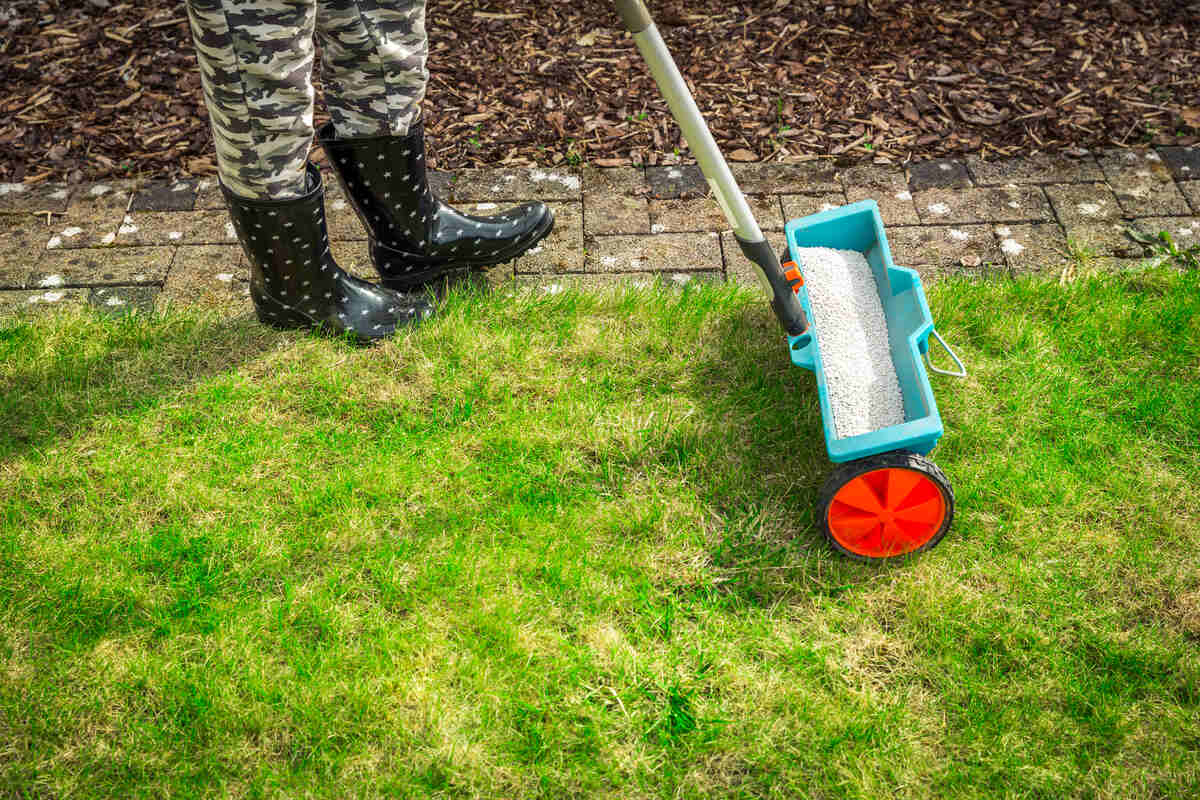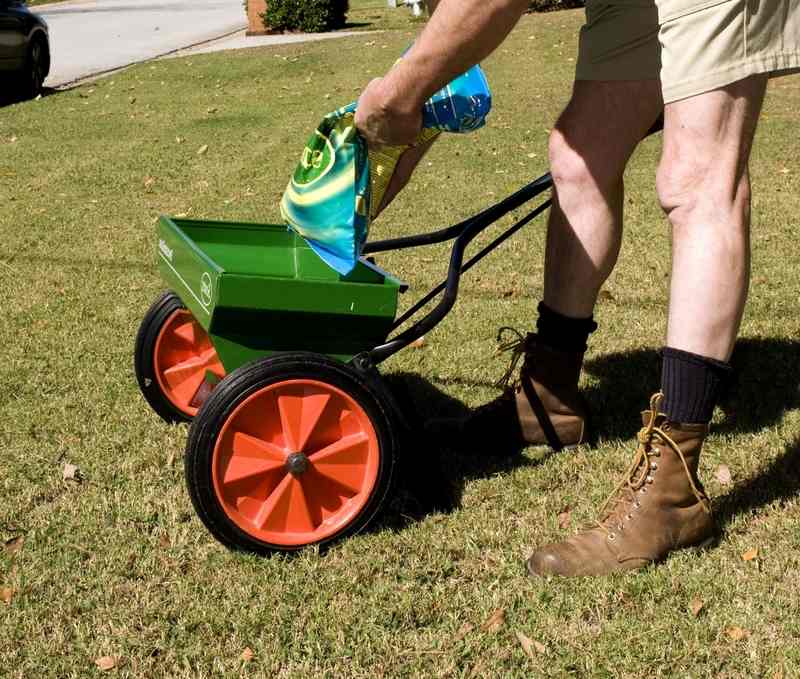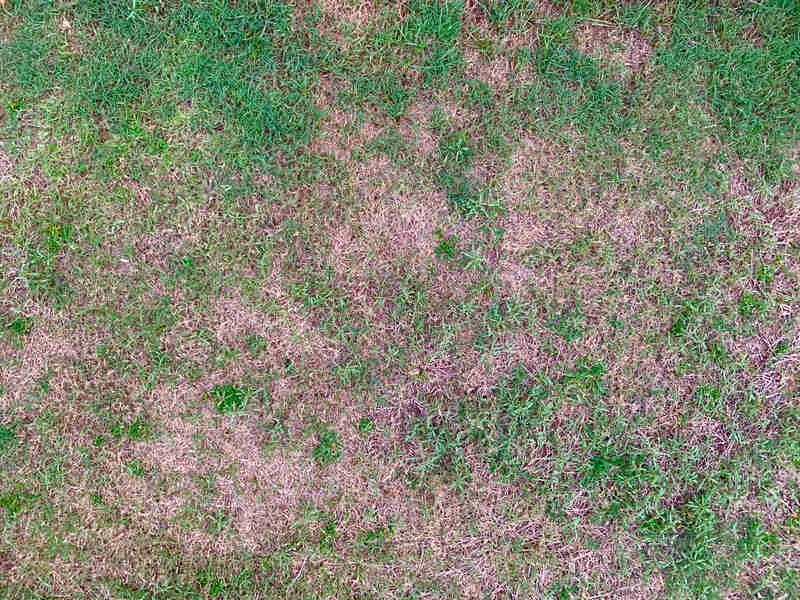
The best time to fertilize a lawn in Indiana is in the fall because cool-season grasses are most common across the state, and fall is their most active growth period when they can best utilize the nutrients in fertilizer. Fertilization in fall also helps the grass prepare for the harsh cold of Indiana’s winters.
If you prefer to fertilize twice a year, the second best time to fertilize your cool-season lawn is in early spring. This is when grass comes out of winter dormancy, and fertilizer gives it a fresh boost for the new year.
Why Fertilize Your Indiana Lawn?

Fertilizing your lawn provides essential nutrients that grass needs to grow, resist diseases, and withstand environmental stressors. Cool-season grasses like Kentucky bluegrass, perennial ryegrass, and fine fescue are prevalent in Indiana and can suffer from lawn diseases and heat and drought stress during the summer if they don’t get the right nutrition.
The best types of grass for Indiana lawns flourish when supplied with suitable amounts of nitrogen, phosphorus, and potassium at the right points in their growth cycle.
- Nitrogen promotes lush, green growth and should be applied sparingly in early spring when the grass is still booting up, then more liberally in fall when the grass is stronger and growing more rapidly.
- Phosphorus supports strong root development and is most useful in early spring when it helps cool-season grasses prepare for the heat and drought of an Indiana summer.
- Potassium enhances disease resistance and the overall health of the grass (see “What Does Potassium Do for Your Lawn?”). Since cool-season grasses are susceptible to lawn diseases in both hot and cold weather, a good helping of potassium can be helpful in both early spring and fall.
Best Time to Fertilize Your Indiana Lawn
If you only plan to fertilize your Indiana lawn once a year, early fall (September – October) is the best time to do it. However, if you want to follow a year-round fertilization program, we recommend the following schedule.
Spring Fertilization
As Indiana emerges from the grip of winter in early spring, you can boost your lawn’s growth with a gentle, low-nitrogen, high-potassium, high-phosphorus fertilizer. This kind of fertilizer in spring promotes early root development and luxuriant green top growth. It’s like a full breakfast for your lawn after a lengthy winter snooze, assisting it to jump-start growth and look its best during the warmer months.
Spring fertilization normally occurs in April or May, depending on the location in Indiana. The basic rule of thumb is to wait until your grass greens up after winter dormancy and starts growing actively again. At this time, look for a slow-release fertilizer with little or no nitrogen to promote sustained nutrient supply, reducing the risk of nitrogen burn while promoting long-lasting, even turfgrass growth.
During spring, grassy weeds like crabgrass can also pop out on cool-season lawns. Consider a weed and feed product to fertilize your lawn and control spring weeds at the same time.
Summer Fertilization
It’s not a good idea to fertilize cool-season lawns at all during summer, especially in hot, dry summers like Indiana’s. These grass types go dormant or slow growth in summer, and fertilizer can force them to grow anyway, exacerbating heat and drought stress.
However, if you just missed spring fertilization, you can apply a slow-release fertilizer with a high amount of potassium in early summer (no later than mid-June).
Fall Fertilization
As autumn approaches, your cool-season grass is gearing up for its most active growth period of the year. It’s time for the second fertilizer application in your lawn, which helps it recover from the stresses of summer, grow thick and healthy throughout fall, and prepare for winter.
Apply a balanced fertilizer in early fall between September and October. It helps the grass grow green and promotes deep root growth.
The last fertilizer application in fall should be at least six weeks before the first expected frost in your area of Indiana, which is usually in late October or early November. For this final fall fertilizer application, use a winterizing fertilizer designed to help your grass survive the upcoming cold weather.
Signs Your Lawn Needs Fertilization

A well-fertilized lawn is vigorous, healthy, and lush. Unhealthy or thin grass may indicate a need to start fertilizing or to adjust your current fertilization program.
Here are some indicators that your lawn is not being fertilized properly:
- Faded or yellowing grass: If your grass loses its vivid green hue and takes on a yellow or pale appearance, it indicates a nutritional deficiency, particularly a nitrogen deficiency. It usually suggests that nitrogen-rich fertilizer is required.
- Slow growth: Stunted or delayed growth indicates your grass isn’t getting the critical nutrients it needs for proper development from your soil. Growth can be hampered by a lack of nitrogen and phosphorus.
- Bare spots or thinning turf: Nutrient deficiency may cause bare spots or thinning sections in your grass. The correct fertilizer can promote thickening and fill in these gaps.
- Invasion of weeds and mosses: A malnourished lawn is more prone to weed and moss infestations. Weeds can compete for resources with your grass, and moss frequently emerges in locations where grass fails to grow.
- Soil compaction: Nutrients may not reach the grass’s roots properly if your soil is compacted, limiting the movement of nutrients and water. Aeration can help loosen compacted soil. Since the best time to aerate the lawn in Indiana is fall, it’s a good idea to aerate compacted soil before fertilizing the lawn so the fertilizer can actually reach your grass’s roots.
- Excessive thatch buildup: Thatch, a dense coating of dead grass and other organic matter on the soil’s surface, can hinder nutrients from reaching the roots. Nutrient absorption can be improved by dethatching the lawn before fertilizing.
- Results of soil tests: A soil test is reliable for determining nutrient deficits. If a soil test shows that certain minerals are deficient, it clearly indicates that your lawn requires nutrient-specific fertilization. For a soil test, you can purchase a DIY kit online or from your local garden supply store or send a sample to a professional lab, such as A&L Great Lakes Laboratories, for more in-depth results and recommendations.
Keep an eye out for these indicators and act quickly with the correct fertilizer to keep your grass in great shape, improving its beauty and resilience to various stressors.
Factors to Consider When Fertilizing the Lawn
When and how to fertilize a lawn in Indiana depends on several factors, including the type of grass, local climate, and your property’s soil conditions. Here are the key factors to consider:
Grass Type
Identify the type of grass in your lawn, as different grasses have unique fertilization needs. Indiana lawns often feature cool-season grasses like Kentucky bluegrass, perennial ryegrass, and fine fescue. The amount of fertilizer recommended for these grass types is listed in the table below.
| Type of Grass | Annual Fertilizer Requirement (per 1,000 sq. ft.) |
| Kentucky Bluegrass | 3 – 4 pounds |
| Fine Fescue | 2 – 3 pounds |
| Perennial ryegrass | 3 – 4 pounds |
| Tall Fescue | 2 – 4 pounds |
Never apply more than 1 pound of nitrogen to your lawn at a time. Split the yearly required amount across two or three applications of 1 pound each, following the fertilization schedule given above for Indiana lawns.
Indiana’s Climate
Comprehending the local climate is fundamental to successful lawn care, especially fertilization. Indiana experiences all four seasons distinctly, from freezing, snowy winters to hot, humid summers. The northern regions experience harsher winters with greater snowfall, and the southern parts have less harsh conditions. Because of this geographical variability, the best time to fertilize your lawn may differ depending on where you live in Indiana.
Always wait to fertilize in spring until the last predicted frost for your area has passed, and be sure to fertilize in fall at least 6 weeks before the first predicted frost.
Soil Test
Conduct a soil test to determine your soil’s nutrient content and pH level. Soil tests provide specific recommendations for the type and amount of fertilizer needed, helping you avoid over-fertilization.
For example, if a test shows that your soil is lacking in phosphorus, you might choose a fertilizer with a higher phosphorus concentration to treat this specific deficiency. Without this information, you may be applying fertilizers that your lawn does not require, thus squandering time and resources.
Choosing the Right Fertilizer
Follow these steps to choose the right fertilizer for your lawn’s specific needs:
- Look for a fertilizer with the nitrogen-phosphorus-potassium (N-P-K) ratio your soil requires. The N-P-K ratio is the combination of three digits on a fertilizer bag that represents the percentage of nitrogen (N), phosphorus (P), and potassium (K) in the product. Your soil test usually identifies which nutrients your soil lacks and which it already contains plenty of.
- Different seasons require different nutrients for better turf growth. For example, you have to be careful not to apply too much nitrogen in spring, as it could burn the grass. Likewise, fertilizers high in potassium are good for late fall applications because they help strengthen the grass before winter weather sets in.
Environmental Regulations
Be aware of local regulations regarding fertilizer use In Indiana. Some areas may restrict certain types of fertilizer, particularly those containing phosphorus, and certain application methods to protect water quality.
You can consult your local Cooperative Extension office or the Indiana State Chemist’s Office for up-to-date information and guidance on responsible fertilization practices in your location.
FAQs About Lawn Fertilization in Indiana
What is the best time to plant grass seed in Indiana?
The best time to plant grass seed in Indiana is early fall, from September to mid-October, when the soil temperature is between 50 and 65 degrees Fahrenheit. This time frame provides the ideal circumstances for cool-season grass seeds to sprout and thrive, with warm (but not too warm) soil and adequate moisture.
When to overseed your Indiana lawn?
As with planting new grass seed, fertilization, and pretty much any other lawn care treatment for cool-season lawns, you should overseed your Indiana lawn in the early fall, at least 45 days before the first frost. During this time of year, the grass is more likely to establish itself and fill in bare spots, resulting in a denser and healthier lawn.
Should you fertilize new grass seed?
If you fertilize new grass seed, be sure to use a starter fertilizer, which is designed to be gentle on new grass while helping it develop strong root and shoot growth.
Lawn Fertilization Services in Indiana
Fertilization is the foundation of a healthy, thriving lawn, as it offers the nutrients your grass needs to thrive. But sometimes, it can be a hassle and time-consuming process. And if you fertilize your lawn at the wrong time or with the wrong type of fertilizer, the results can be disastrous.
Long story short, getting lawn care right is hard. That’s why LawnStarter makes it easy for you with our Indiana lawn care pros who can help with fertilization, weed control, lawn mowing, and all your other lawn care needs. Whether you’re in the heart of Indianapolis or at the fringes of Gary or New Albany, we have licensed, insured, and background-checked LawnStarter pros in your neighborhood.
Main Photo Credit: Brebca / Adobe Stock